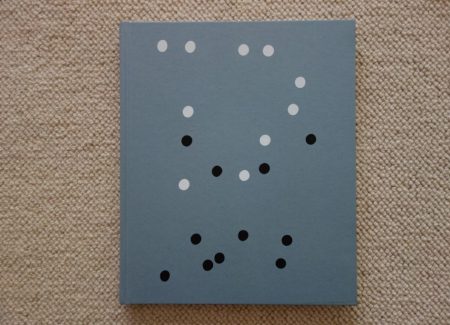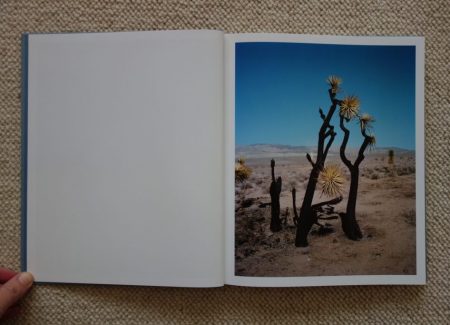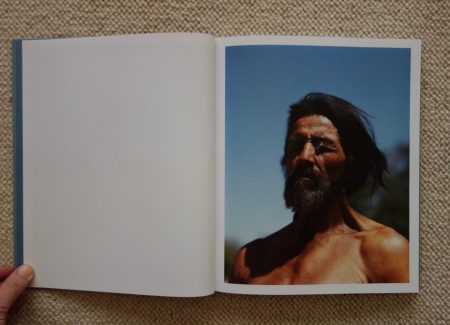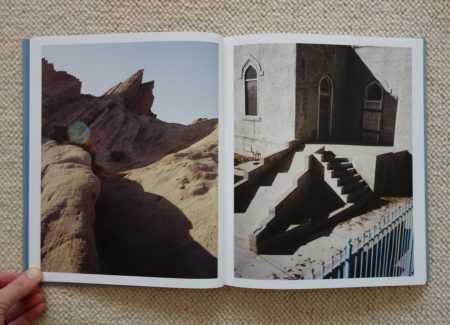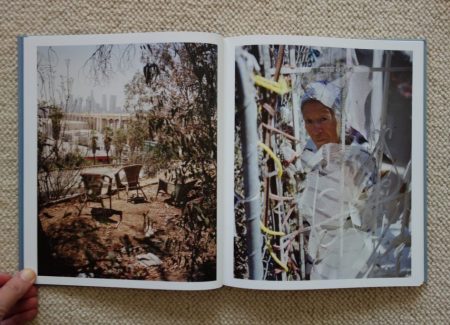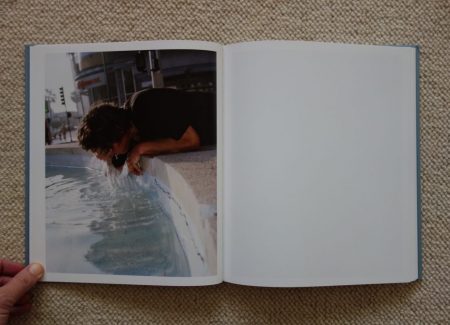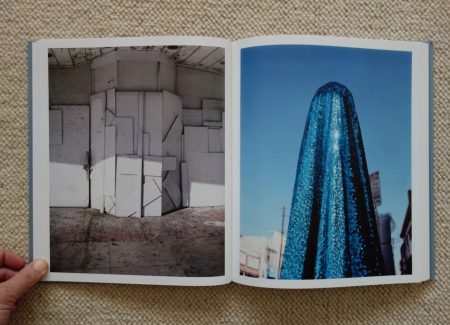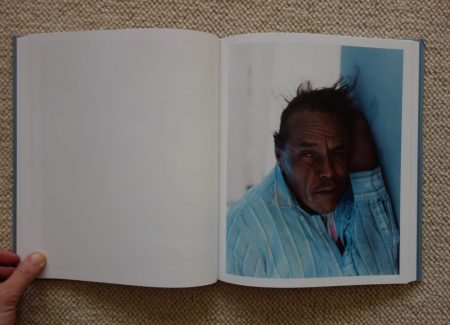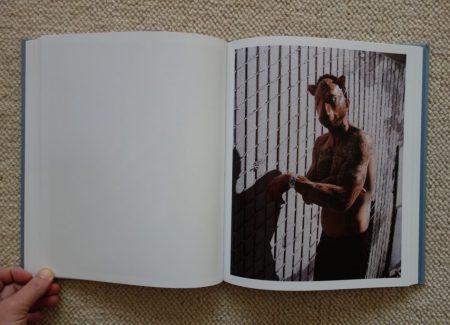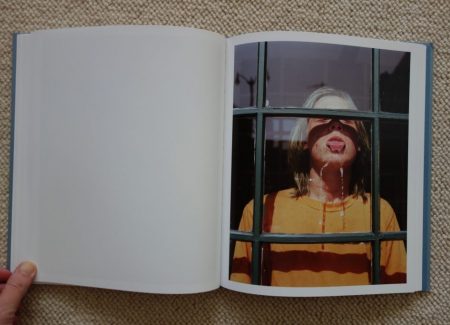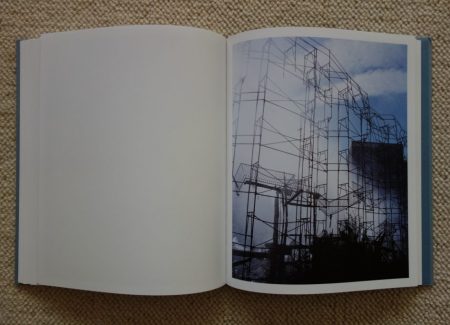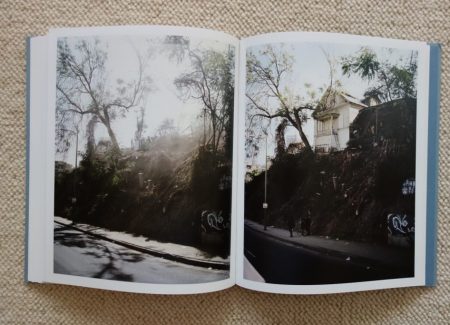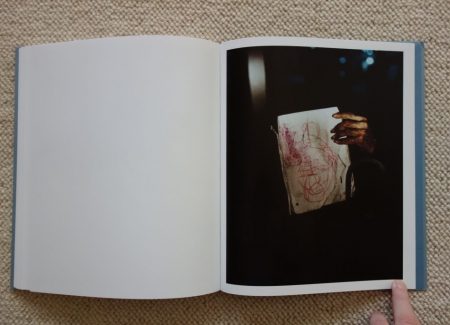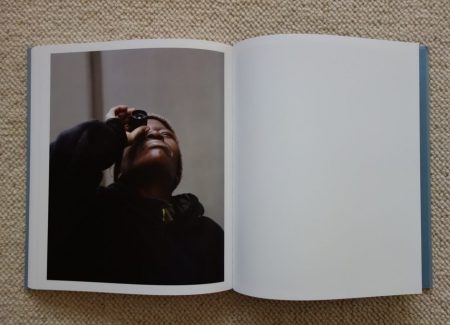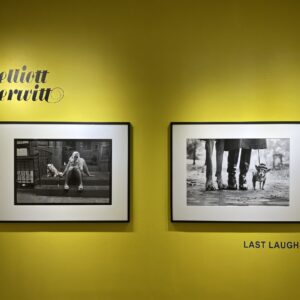JTF (just the facts): Published in 2016 by MACK Books (here). Hardcover, 128 pages, with 77 color reproductions. There are no texts or essays included. (Cover and spread shots below.)
Comments/Context: In the past decade, a surprisingly large and talented group of contemporary photographers has been drawn to the harsh pathways of 21st century American desperation. Artistically raised on the quietly caustic moods of Robert Frank, many have taken to the road themselves, patiently burrowing into the underbelly of cities and towns across this vast country. Peering in at marginalized communities (largely from the vantage point of the outsider), they have strongly felt the frustration, the weariness, and the estrangement of the forgotten and invisible, making pictures that often capture the simmering sense of anger and unease that haunts these places.
Given the title of Gregory Halpern’s new photobook – ZZYZX – we can safely assume that he too has traveled to the proverbial end of the line, both physically and psychologically. Purportedly the last word in the English dictionary and the name of a nowhere town in the middle of the Mojave desert, ZZYZX follows along as Halpern wanders from the sun scorched lands to the east of Los Angeles (some still literally on fire) all the way west to the waters of the Pacific Ocean. Like many photographic journeys, it exposes us to the incremental changes in the on-the-ground landscape and acquaints us with various characters encountered along the way, but Halpern’s trip is more than a hackneyed travelogue – it bites with real force, even when it is delivering indirect and glancing blows.
This intensity is largely a result of how Halpern makes pictures. Every image in this book is vertically oriented, and nearly all of the pictures employ the straightforward central framing of a singular subject. This pared down approach creates a sense of slowness that demands our full attention – these aren’t tossed off pics or lucky snapshots, but people, places, and things that were selected and photographed with extreme deliberation and care, often with a particular effort to remove them from their surrounding context. He’s asking us to look very closely at what he’s seen, and offering us few options to do otherwise.
If this incisively crafted viewpoint was all that Halpern was delivering in ZZYZX, his book might not immediately seem dissimilar from any number of recent photobooks chock full of isolated photographic discoveries. But where this photobook excels is in its truly masterful sequencing – we will be hard pressed to find a photobook this year that is sequenced with more thoughtful nuance. To some, such a pronouncement might seem like a hollow victory, or even better, the ravings of an arcane photobook enthusiast getting lost down in the weeds of the unimportant minutiae. But if we pay close attention to how the images in this book have been edited and ordered, suddenly some durable magic appears in ZZYZX, giving a silly maxim like the whole being better than the sum of its parts some real weight.
The melody line in ZZYZX comes from Halpern’s geographic journey across the city. It starts in the desert, with images of burning brush, charred trunks, boulders, and sandy expanses interrupted by rocky outcrops, and ends with salty spray, crashing waves, and sunset beaches. In between, Halpern heads down the highway toward the city, constantly looking through stands of eucalyptus trees or metal fencing, with housing developments and the city skyline just out of reach. Once he finally gets to Los Angeles, he takes to the streets and we see more evidence of the urban landscape, from bus stops and gleaming skyscrapers to concrete apartment blocks and cement sidewalks. As he keeps moving, we ultimately reach the hills on the coast, with airplanes in the dark night sky and lights dotting the hillsides.
Interwoven with this main progression are seemingly dozens of smaller visual harmonies, where motifs and themes are introduced and repeated like small refrains and choruses. LA’s slack jawed need for water rises again and again – in a dripping spigot with a watery trail across the sidewalk, a desperate hot headed face dunked into a nearby city fountain, and a self-satisfied portrait of a teenage girl soaked from head to toe. Doubled images (either side by side or separated by a number of page turns) more obviously force us to look again – at two views of a squiggle of white hair down the back of man’s neck, at a before and after scene of a rundown wooden house that is torn down, and at a two-season look at the same concrete stairway, the hillside alternately covered in lush grass and dry dirt. And animals pop up now and then, reminding us of their uneasy place in this urban landscape, from a pigeon on a tether and a blackbird perched on a curb to horses and bunnies caught in in-between zones.
Sometimes the visual echo comes from just two images. Halpern gives us refrains of openings (a tunnel followed by an open mouth), vertical forms (a gleaming building followed by a tall sequined shawl), gridded metal (a steel security gate followed by a homeless man’s shopping cart) and seeing through glass (eyeglasses raised up followed by a smashed car windshield), while other forms and behaviors repeat more consistently across the arc of the narrative – long hair, hands, masks, looking skyward, scrawled notes, and slumped figures. Part of me wants to see a complete diagram of every image in this volume and its many connections to others, if only to follow the pathways I have missed – seen this way, ZZYZX must look like a densely complex network, with countless intricacies and connection points.
Halpern’s many excellent portraits are what give life and roundness to this story, but their consistently tender grimness adds up over the course of the book. Some of his subjects are obviously homeless, but nearly all seem down on their luck or otherwise living on the fringes. These are the same kind of people that have also inhabited Katy Grannan’s portraits of late – everyday fighters and survivors of all ages, genders, and ethnicities, who alternate between momentary swagger and more pervasive bone weary pessimism. Answers are looked for in many places – in a far off look, in crazed scribblings, in a telescope glance at the stars – but the irony of the grubby hand finding solace in a movie playing on a smartphone hits hard. This is a book that quietly undermines every glamorous aspect of Los Angeles, the jeweled crown bluntly revealed as cheap plastic.
Seen together, the images in ZZYZX coalesce into an unexpectedly sophisticated product, the sequencing of the photobook seducing us with its layers of interleaved ideas and visual echoes. To employ one last musical metaphor, this richness of construction makes Halpern’s “sound” incredibly full. His portrait of contemporary Los Angeles is dour and disheartening to be sure, but it resonates with a thick hyper-attentive three-dimensionality that won’t let us look away.
Collector’s POV: Gregory Halpern is represented by Webber Represents (here) in London and New York. Halpern’s work has little secondary market history, so gallery retail likely remains the best option for those collectors interested in following up.
